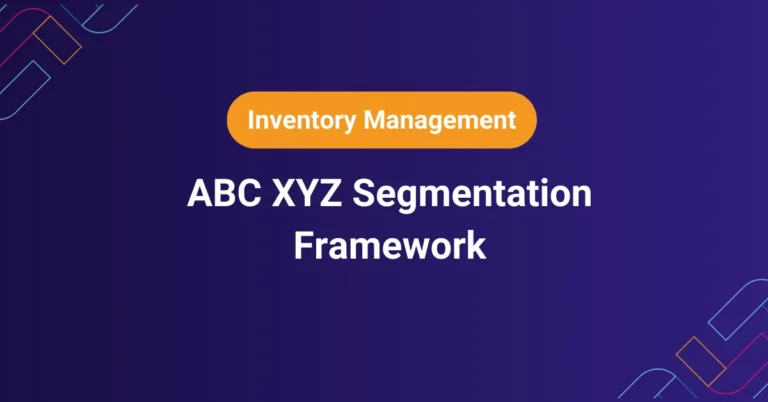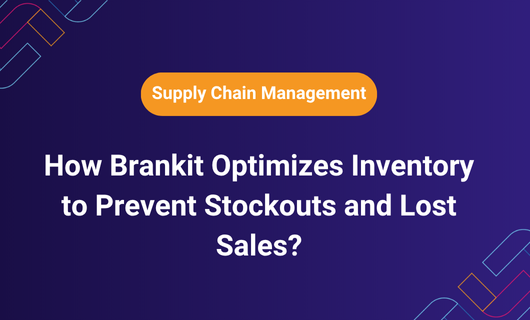Is your operations budget stretched thin, trying to give every one of your SKUs the same level of attention? This costly approach leaves high-value items vulnerable to stockouts while slow-movers drain your cash flow. What is the true impact of these inventory mistakes on your bottom line? Imagine instead a system where your team’s efforts are precisely targeted, your capital is unlocked, and stockouts become a rarity.
This is the operational clarity provided by ABC XYZ inventory segmentation. It’s a strategic framework that moves you from guesswork to ecommerce inventory forecasting, ensuring every dollar of your ops budget is spent protecting revenue and maximizing efficiency.
A Strategic Framework for Inventory Control
Moving beyond a one-size-fits-all approach requires a fundamental shift in perspective. ABC XYZ inventory segmentation provides the strategic framework for this shift, replacing blanket policies with a nuanced, data-driven model for decision-making. It forces you to ask two critical questions about every item in your warehouse: “How valuable is it?” and “How predictable is it?” The answers to these questions become the basis for allocating your finite resources—budget, space, and labor—with surgical precision, ensuring maximum protection for your revenue and minimal waste on low-priority stock. This isn’t just an inventory tactic; it’s the core of B2B e-commerce supply chain management, driving efficiency, scalability, and smarter operations.

Deconstructing the ABC XYZ Methodology
ABC XYZ segmentation is the powerful combination of two distinct classification lenses, giving you a complete, 360-degree view of your inventory’s value and behavior.
The ABC Analysis: A Financial Lens
ABC analysis categorizes your products based solely on their financial contribution to your annual revenue or profit, following a common Pareto principle (80/20) pattern.
Class A Items: The Vital Few. The top 10-20% of your SKUs that typically generate about 70-80% of your revenue. These are your business’s crown jewels and demand the highest level of control and investment.
Class B Items: The Middle Ground. The next 20-30% of SKUs, contributing roughly 15-20% of revenue. These are important supporting players that require standard, efficient management.
Class C Items: The Trivial Many. The bottom 50-60% of SKUs that only make up about 5-10% of revenue. These are your long-tail items that should require minimal operational overhead.
The XYZ Analysis: A Demand Predictability Lens
While ABC looks at “how much,” XYZ analysis examines “how often and how consistently,” measuring demand variability.
Class X Items: Steady Demand. These SKUs have highly predictable, stable sales with little fluctuation. Forecast accuracy is high (e.g., less than 15% error). Examples include subscription refills, consumables, or perennial bestsellers.
Class Y Items: Fluctuating Demand. Demand is predictable but shows clear trends, seasonality, or cyclical patterns. Forecast error is moderate. Think seasonal apparel, holiday items, or products influenced by trends.
Class Z Items: Erratic Demand. These are the hardest to predict. Sales are sporadic, infrequent, and lack any clear pattern. New products, emergency parts, or very niche items fall here.
Plot each SKU on a 3×3 grid using its assigned ABC and XYZ classification. This visual matrix is your new master blueprint for inventory control, revealing nine distinct segments from critical AX items to low-priority CZ items.
The ABC Analysis: Classifying by Financial Impact
ABC analysis categorizes your products based on their contribution to your annual revenue or profit, following a common Pareto principle (80/20) pattern.
Class A Items: The top 10-20% of your SKUs that typically generate about 70-80% of your revenue. These are your business’s crown jewels and deserve the highest level of control.
Class B Items: The next 20-30% of SKUs, contributing roughly 15-20% of revenue. These are important but not critical; they require standard management.
Class C Items: The bottom 50-60% of SKUs that only make up about 5-10% of revenue. These are your long-tail items that should require minimal operational overhead.
For the XYZ analysis, calculate the Coefficient of Variation (CV) for each SKU’s monthly demand: CV = (Standard Deviation of Monthly Demand) / (Average Monthly Demand).
X-Items: Low CV (e.g., < 0.5)
Y-Items: Medium CV (e.g., 0.5 – 1.0)
Z-Items: High CV (e.g., > 1.0)
The XYZ Analysis: Classifying by Demand Predictability
While ABC looks at value, XYZ analysis examines demand variability—how consistently an item sells.
Class X Items: Steady Demand. These SKUs have highly predictable sales with little fluctuation. Forecast accuracy is high (e.g., less than 15% error). Examples include subscription refills, consumables, or perennial bestsellers.
Class Y Items: Fluctuating Demand. Demand for these items is predictable but shows clear trends, seasonality, or cyclical patterns. Forecast error is moderate. Think seasonal apparel, holiday items, or products influenced by trends.
Class Z Items: Erratic Demand. These are the hardest to predict. Sales are sporadic and lack any clear pattern. New products, emergency parts, or items with very intermittent sales fall here.
Implementing the Framework: A Step-by-Step Guide
Executing ABC XYZ segmentation is a methodical process that transforms raw data into an actionable inventory strategy.
Step 1: Data Aggregation and Preparation
The foundation of accurate segmentation is clean, historical data. Export 12 to 24 months of data for every active SKU. Essential data points include: SKU ID, Quantity Sold (by month), Unit Cost, and Selling Price.
Step 2: Calculating Annual Consumption Value
For each SKU, calculate its total annual contribution. This can be done using Annual Revenue (Quantity Sold * Selling Price) or Annual Consumption Value (Quantity Sold * Unit Cost) for a cost-focused view. This value is the basis for your ABC classification.
Step 3: Executing the ABC Classification
Sort your entire SKU list by the calculated annual value in descending order. Calculate the cumulative percentage of the total value. Apply the ABC classes:
A-Items: Top ~70-80% of the total cumulative value.
B-Items: Next ~15-20% of the cumulative value.
C-Items: Remaining ~5-10% of the cumulative value.
Step 4: Calculating Demand Variability (Coefficient of Variation)
Plot each SKU on a 3×3 grid using its assigned ABC and XYZ classification. This visual matrix is your new master blueprint for inventory control, revealing nine distinct segments from critical AX items to low-priority CZ items.
Step 5: Plotting the Final Segmentation Matrix
Plot each SKU on a 3×3 grid using its assigned ABC and XYZ classification. This visual matrix is your new master blueprint for inventory control, revealing nine distinct segments from critical AX items to low-priority CZ items.
Applying Policies for Maximum ROI
The true power of this exercise is realized when you create distinct operational rules for each segment, directly impacting your budget allocation.
Inventory Policies and Service Level Targets
Your approach to inventory-management, safety stock, and service level targets must vary dramatically by segment to be effective and cost-efficient.
| Segment | Risk Profile | Service Level Target | Inventory Policy & Action |
|---|---|---|---|
| AX | High Value, Predictable | 98-99% | Tight control. Low safety stock. Prioritized replenishment. |
| AY | High Value, Unpredictable | 95-98% | Strategic focus. Higher safety stock. Use advanced forecasting. |
| AZ | High Value, Erratic | 90-95% | Major challenge. Consider JIT or on-demand ordering. |
| BX | Medium Value, Predictable | 90-95% | Standard control. Moderate safety stock. Efficient reorder points. |
| BY | Medium Value, Unpredictable | 85-90% | Monitor closely. Use trend forecasting. Medium safety stock. |
| BZ | Medium Value, Erratic | 80-85% | Consider vendor-managed inventory or dropshipping. Low safety stock. |
| CX | Low Value, Predictable | 80-85% | Minimal control. Bulk order to save time. Very low safety stock. |
| CY | Low Value, Unpredictable | <80% | Consider eliminating or making to order. No safety stock. |
| CZ | Low Value, Erratic | <80% | Prime candidate for liquidation or removal. No safety stock. |
Aligning Cycle Counting with Segmented Value
Your most expensive operational cost is warehouse labor. ABC/XYZ segmentation dictates where their time is best spent.
A-Class Items: Require frequent cycle counts—weekly or even daily. The goal is near-perfect record accuracy because a discrepancy here directly impacts revenue.
B-Class Items: Counted less frequently, perhaps monthly or quarterly. This ensures general accuracy without consuming excessive resources.
C-Class Items: Counted annually or via random spot checks during other activities. The cost of frequent counting outweighs the benefit.
Managing Exceptions: Seasonality and New Products
Seasonal Products: These are classic Y-items. Their policy must be time-based. Ramp up inventory to segment-specific levels before the season and plan for aggressive sell-through or returns afterward to avoid becoming dead stock.
Promotional Items: A normally stable BX item might temporarily become an AY or AZ item during a major sale. Your processes must be agile enough to temporarily adjust safety stock and focus during these periods.
Leveraging Technology for Automation
Manually managing this in spreadsheets is possible but not scalable. Integration and inventory accuracy services are key to automation and real-time precision. Modern Warehouse Management Systems (WMS) and Enterprise Resource Planning (ERP) platforms can automate the entire process: data collection, CV calculation, reclassification, and the application of different replenishment rules for each segment.
Frequently Asked Questions
The primary goal is to eliminate a one-size-fits-all inventory policy. It allows you to strategically allocate limited resources—like capital for stock, warehouse space, and valuable staff time for counting—exclusively to the products where it will have the greatest impact on revenue, customer satisfaction, and profit protection.
It allows targeted service level investment. For high-value, predictable (AX) items, aim for near-perfect service levels (98–99%) to protect most of your revenue. Lower levels can be set for low-value, unpredictable SKUs, avoiding the high cost of uniform targets across all items.
You need at least one full year of historical sales data for each SKU to account for seasonality and generate a reliable average and standard deviation for demand. Using only a few months of data will create a highly inaccurate and misleading segmentation.
For most growing e-commerce businesses, A-class SKUs should be counted monthly—and weekly for high-velocity or high-value items. Set frequency based on the risk and cost of errors, as stockouts on top sellers cost more than frequent counts.
Stop Letting Inefficiency Drain Your Budget
ABC XYZ inventory segmentation is the essential blueprint for intelligent, profit-driven inventory control. It transforms your operations from a reactive cost center into a proactive strategic asset, directly contributing to improved cash flow, higher service levels, and significantly reduced operational waste.
The theory is clear. The implementation—integrating clean data, setting intelligent policies, and aligning your team or 3PL—is where most operations leaders need expert support.
Ready to transform your inventory strategy? Schedule a free, no-obligation consultation with our supply chain specialists. We’ll analyze your top SKUs and provide a customized roadmap to implement ABC XYZ segmentation and start freeing up your budget and your time. Schedule a Free Supply Chain Review.





